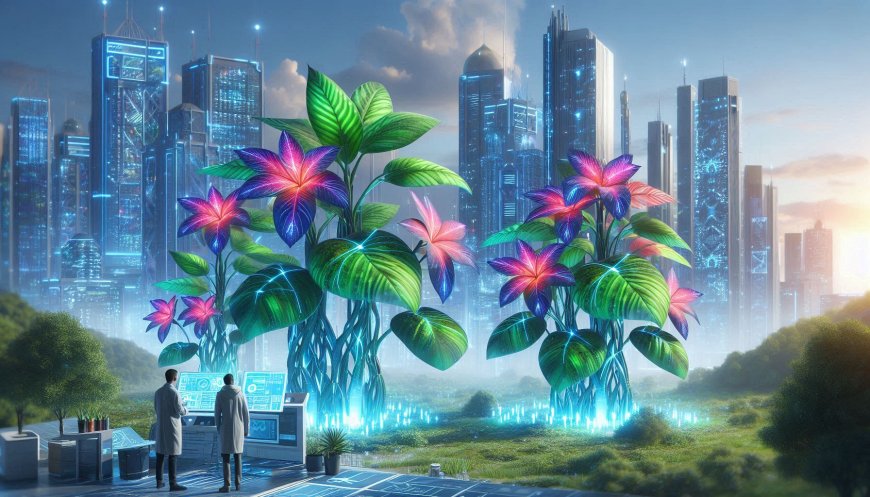Color-Changing Plants: The Future of Environmental Watchdogs
Explore the future of environmental monitoring with color-changing plants that react to pollution and climate shifts. Discover how these innovative plants act as natural environmental watchdogs, offering real-time data on ecological changes.

Imagine walking through your garden, admiring the greenery, when suddenly, one of your plants turns a vibrant shade of red. No, it's not autumn—it’s a warning. Thanks to pioneering scientists at the University of California – Riverside, this scenario could soon be a reality. They’ve engineered plant biosensors that change color in the presence of specific harmful chemicals, transforming plants from simple ornaments into environmental watchdogs.
Innovative Plant Biosensors: A Garden of Possibilities
It all started with a fascinating question: What if a house plant could detect dangerous contaminants in your surroundings? The researchers at UC Riverside turned this idea into a groundbreaking reality. They created a plant that changes color when exposed to a toxic pesticide called azinphos-ethyl, which has long been banned due to its hazardous effects. In the presence of this pesticide, the plant’s leaves turn beet red, offering an unmistakable signal that danger is lurking in the environment.
According to Ian Wheeldon, associate professor of chemical and environmental engineering at UC Riverside, this achievement opens the door to a new era of environmental monitoring. “We’ve engineered the plant to alert us without disrupting its natural functions,” he explained. Previous attempts at creating plant biosensors often interfered with the plant's growth or ability to absorb water. But this new method preserves the plant’s health, ensuring that it can still thrive while also acting as a chemical detector.
How It Works: Plants as Chemical Detectors
At the core of this remarkable transformation lies a naturally occurring protein in plants called abscisic acid (ABA). Under stressful conditions, such as drought, plants produce ABA to signal themselves to conserve water. The UC Riverside team discovered a way to reprogram ABA receptors to respond to contaminants like azinphos-ethyl instead. When the receptor binds with the toxic chemical, the plant undergoes a striking color change, acting like a natural, built-in alarm system.
The research, published in Nature Chemical Biology, demonstrates how plants could one day serve as more than just decorative pieces—they could be essential tools in environmental health, protecting us from unseen dangers in our air, water, and soil.
From Plants to Yeast: Expanding the Biosensor Spectrum
The UC Riverside team didn’t stop with plants. They expanded their research to include yeast, engineering it to detect two different chemicals at once—an ability that hasn’t yet been achieved with plants. This breakthrough opens the possibility of developing biosensors that can monitor multiple harmful substances simultaneously.
Sean Cutler, a professor of plant cell biology at UCR, envisions a future where plants could detect a wide array of harmful chemicals. “Imagine a plant capable of sensing 100 banned pesticides,” Cutler said. “The applications for environmental health, agriculture, and even national defense are immense.” Though the technology is still in its early stages, the team sees great potential for plant biosensors to revolutionize the way we monitor the environment.
The Road Ahead: Challenges and Promise
While these color-changing plants hold great promise, they won’t be available to the public anytime soon. Commercializing these engineered plants will require navigating strict regulatory hurdles, and it may take years before they are ready for widespread use. Moreover, developing plants that can detect a broader range of chemicals, including pharmaceuticals that seep into water supplies, remains a challenge.
But the potential is undeniable. Cutler believes that one day, we could have plants capable of detecting all kinds of environmental chemicals, from industrial pollutants to common household drugs. “The technology to sense these contaminants is within reach,” he said. “And the implications for our health and the planet are profound.”
A Future Where Plants Protect Us
The idea of plants turning colors to warn us about toxins may seem futuristic, but this innovative research brings it one step closer to reality. As scientists continue to push the boundaries of plant biology, we may soon see a world where our gardens and houseplants serve not only as sources of beauty but as sentinels, safeguarding our environment and health in the most natural way possible.
What's Your Reaction?






































































































